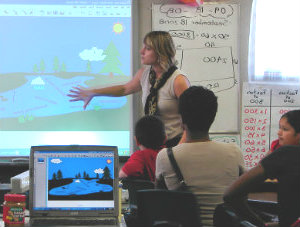Tearing Down Common Co-Teaching Barriers
A MiddleWeb Blog
 As the year continues to flash by, let’s capture the moments of this school year now. By now it is fairly reasonable to predict that co-teachers all over the globe are in that “next year I will…” mode. It is great to look ahead, but don’t let what remains of this school year pass you or your students by.
As the year continues to flash by, let’s capture the moments of this school year now. By now it is fairly reasonable to predict that co-teachers all over the globe are in that “next year I will…” mode. It is great to look ahead, but don’t let what remains of this school year pass you or your students by.
Take a second to breathe in the Now—and ask yourself, How can I maximize the learning for my students this year? What can I do with my co-teacher to strengthen our important work together?
In recent conversations and personal reflections, I’ve been revisiting some common barriers that co-teachers in any inclusive setting need to work through. Overcoming these barriers helps us gain the peace of mind that comes from providing our students with access to learning, while optimizing opportunities for students to achieve their personal best.
So let’s get right to three all too frequent co-teaching barriers that we need to push aside for the rest of this school year and beyond!
Finding co-planning time
Meeting before or after school is a given—but what about if your co-teacher seems to be constantly on the go? Simplify your schedules by creating a once a week time (at least) and have a back-up day if and when that day doesn’t work.
In between your weekly in-person planning time, open up a shared Google Doc to stay connected. And if Google Doc sharing isn’t comfortable for you or your co-teacher, keep communication in the moment with a post-it exchange system. After any (or each) class, jot your thoughts about how the lesson went on a post-it, and exchange these tidbits of golden thinking before you run out the door to your next class.
We have planning time, now what?

Make sure that you make the most of your co-planning time by creating a planning guideline. Simply write the lesson objective and which teacher will be responsible for what part of the prep and what part of the implementation. Check out 2 Teach, LLC with CEO and President Wendy Murawski, for valuable examples and resources.
How do we adapt the instructional process?
As teachers focus on learning objectives and plan meaningful lessons, it’s time to review how to plan for the actual learning time. Consider your students (all students—not just the students with IEP’s) and . . .
► Proactively differentiate your instruction using the principles and learning guidelines of Universal Design for Learning.
► Make structural changes by including varied co-teaching models.

► Vary questioning through techniques such as Socratic Questioning to guide students to process and take ownership of their learning rather than having them passively remembering what they read or what the teachers say.
► Provide multiple ways of sharing information with students. For example use tools such as ShowMe Interactive Whiteboard to provide additional video and audio input.
► Make students part of the process! Provide opportunities for students to stay informed of their progress and self-monitor their academic moves accordingly.
► Be sure to provide options for students to express their thinking.
► Be creative—provide options for drawing, writing, speaking, and moving about the room. These options will guide them to connect personally to whatever content they need to know.

I hope this post has sparked some thinking — both validating the great co-teaching happening out there, and igniting those of you who need a quick pick me up! Just select one area to focus on—take the plunge—put yourself out there—and make a difference—this year.You’ll be glad you did!
What is one takeaway from this post that could energize you and your co-teacher this year? What ideas do you have for busting through co-teaching barriers? Let’s do it—together!































